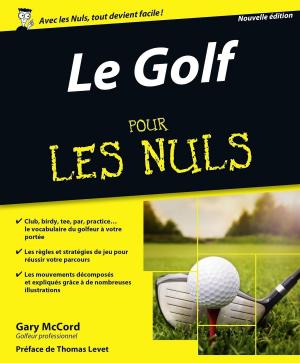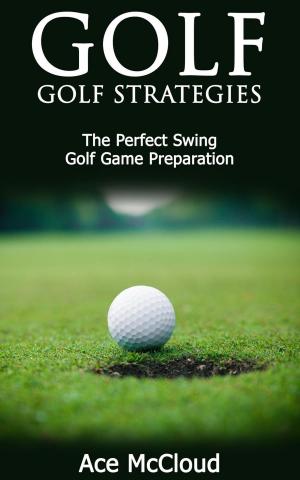| Author: | Stuart Smith | ISBN: | 9781310584572 |
| Publisher: | Stuart Smith | Publication: | November 13, 2014 |
| Imprint: | Smashwords Edition | Language: | English |
| Author: | Stuart Smith |
| ISBN: | 9781310584572 |
| Publisher: | Stuart Smith |
| Publication: | November 13, 2014 |
| Imprint: | Smashwords Edition |
| Language: | English |
Q What does the loft of the club dictate when chipping?
You would answer
A Height
and you would be WRONG.
What you need to know is why you are wrong and what the loft of the club does dictate when chipping, and reading this book will teach you this and much more.
This book will help you to
Understand exactly what a chip is as most golfers
misunderstand this shot and visualise it incorrectly, thus reducing the chances of playing it well. A chip shot is one from just off the green, where you need to fly the ball over an obstacle such as:
Some fairway
A bunker
A hump or hollow
A tier on a green
A water hazard
You will learn the Seven vital steps that you must repeat for you to hit great chip shots time after time.
There are four different techniques that this book covers which are
Standard Chip - a standard chip is a shot
that has the designated amount of energy the club’s loft dictates.
We are aiming to strike the ball with the true loft of the club without changing the amount of energy that each club produces to alter the shot. In other words, we are not going to de-loft or open the face at set-up or impact for this chip. The ball will not fly very high nor will it come out low and fast. This chip has a standard flight and roll which is dictated by the club’s loft alone. A 7-iron will fly lower and run longer than a pitching wedge.
Running/High Energy Chip - This chip or technique is designed to give the ball a lot more energy than the loft of the club would impart on its own. Using a pitching wedge for this technique will ensure the ball will run as much as it would do if you used a 7-iron and employed the technique for a standard chip.
Soft Landing Chip -
It has a soft flight
Lands softly on the green
Has a gentle low energy release towards the hole
When you have been told to make a putting stroke for your chip, this is the shot you are executing. This shot would normally be used when you have a very fast downhill chip and you need to carry the fringe or you have very little green between the edge of the green and the hole.
Lob Shot - I would like to see this shot renamed the ‘stop quickly shot’ or ‘very low energy shot’ as, rather than thinking you need to lob it up high, this is what you need it to do.Because it is called the lob shot, most golfers try to get the ball up high, which then makes the chance of failure much greater. You would normally play this shot when you are behind an obstacle, such as a bunker or a mound, and the pin is close to the edge of the green leaving you very little space in which to land the ball and stop it near the hole. A lob shot requires very low energy once landed on a green. The best way to create very low energy is to play the shot with as much loft as possible on the club. As a result, it’s odds on the ball will go up high.
Without landing the ball in the correct place on the green the above four techniques will not help. This book will teach you how to select a good landing zone and how to practice hitting your zone. Picking one and landing it there is two very different things.
Q What does the loft of the club dictate when chipping?
You would answer
A Height
and you would be WRONG.
What you need to know is why you are wrong and what the loft of the club does dictate when chipping, and reading this book will teach you this and much more.
This book will help you to
Understand exactly what a chip is as most golfers
misunderstand this shot and visualise it incorrectly, thus reducing the chances of playing it well. A chip shot is one from just off the green, where you need to fly the ball over an obstacle such as:
Some fairway
A bunker
A hump or hollow
A tier on a green
A water hazard
You will learn the Seven vital steps that you must repeat for you to hit great chip shots time after time.
There are four different techniques that this book covers which are
Standard Chip - a standard chip is a shot
that has the designated amount of energy the club’s loft dictates.
We are aiming to strike the ball with the true loft of the club without changing the amount of energy that each club produces to alter the shot. In other words, we are not going to de-loft or open the face at set-up or impact for this chip. The ball will not fly very high nor will it come out low and fast. This chip has a standard flight and roll which is dictated by the club’s loft alone. A 7-iron will fly lower and run longer than a pitching wedge.
Running/High Energy Chip - This chip or technique is designed to give the ball a lot more energy than the loft of the club would impart on its own. Using a pitching wedge for this technique will ensure the ball will run as much as it would do if you used a 7-iron and employed the technique for a standard chip.
Soft Landing Chip -
It has a soft flight
Lands softly on the green
Has a gentle low energy release towards the hole
When you have been told to make a putting stroke for your chip, this is the shot you are executing. This shot would normally be used when you have a very fast downhill chip and you need to carry the fringe or you have very little green between the edge of the green and the hole.
Lob Shot - I would like to see this shot renamed the ‘stop quickly shot’ or ‘very low energy shot’ as, rather than thinking you need to lob it up high, this is what you need it to do.Because it is called the lob shot, most golfers try to get the ball up high, which then makes the chance of failure much greater. You would normally play this shot when you are behind an obstacle, such as a bunker or a mound, and the pin is close to the edge of the green leaving you very little space in which to land the ball and stop it near the hole. A lob shot requires very low energy once landed on a green. The best way to create very low energy is to play the shot with as much loft as possible on the club. As a result, it’s odds on the ball will go up high.
Without landing the ball in the correct place on the green the above four techniques will not help. This book will teach you how to select a good landing zone and how to practice hitting your zone. Picking one and landing it there is two very different things.















